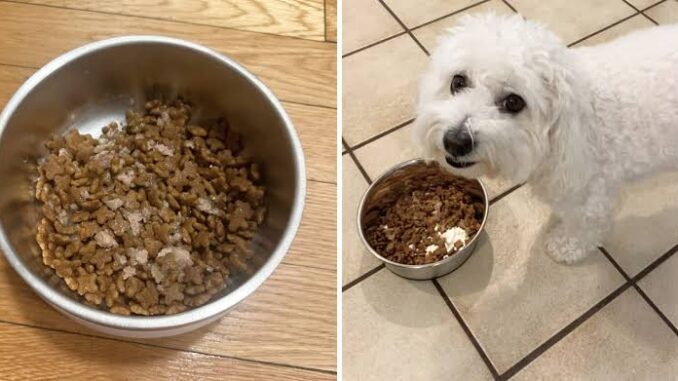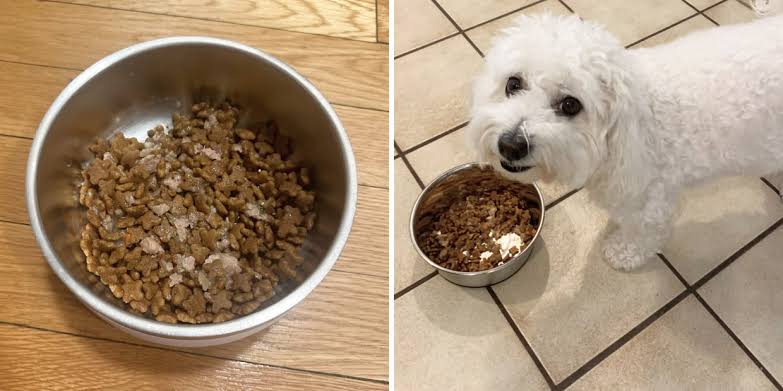
Best Dog Food for Sensitive Stomachs in 2025: A dog’s stomach can be surprisingly delicate. While some pups can eat just about anything with no issue, others suffer from frequent vomiting, loose stools, gas, or even skin irritation due to food sensitivities. If your dog struggles with digestive issues, switching to a specialized diet formulated for sensitive stomachs can dramatically improve their quality of life.

In 2025, the pet food industry has grown more conscious of dogs with dietary sensitivities. New formulas, cleaner ingredient lists, and advanced nutrition science have made it easier than ever to find a food that supports healthy digestion.
This guide walks you through understanding digestive sensitivities in dogs, how to choose the right food, and reviews some of the best dog food options available in 2025.
Understanding Sensitive Stomachs in Dogs
A “sensitive stomach” isn’t a diagnosis it’s a symptom. Dogs with sensitive stomachs often show signs like:
- Frequent vomiting
- Diarrhea or loose stools
- Excessive gas
- Lack of appetite
- Skin issues or ear infections (linked to food allergies)
- Weight loss or failure to gain weight
These issues can arise from a variety of causes, including:
- Food allergies or intolerances
- Sudden changes in diet
- Poor-quality ingredients
- Overeating or eating too quickly
- Underlying medical conditions (e.g., pancreatitis, IBD, parasites)
Before switching foods, it’s important to consult a veterinarian to rule out more serious medical issues. Once cleared, diet is the most powerful tool in managing chronic digestive discomfort.
What to Look for in Dog Food for Sensitive Stomachs
When selecting a food for sensitive stomachs, several nutritional principles apply. In 2025, many top-tier dog foods reflect these traits:
1. Limited Ingredient Formulas
Fewer ingredients reduce the chance of triggering a reaction. Look for foods that use a single protein source and limited carbohydrates.
2. Easily Digestible Ingredients
Foods with lean meats, whole grains like brown rice or oatmeal, and low-fiber vegetables are easier on the gut. Avoid soy, corn, and wheat, which can be harder to digest.
3. Novel or Hydrolyzed Proteins
Novel proteins like duck, venison, or salmon are less likely to cause reactions. Hydrolyzed proteins are broken down into smaller components that are less likely to trigger allergies.
4. Added Probiotics and Prebiotics
Live beneficial bacteria (probiotics) and dietary fibers (prebiotics) help maintain gut flora balance, reducing gas and supporting digestion.
5. Grain-Free or Whole-Grain Options
Grain-free diets are often recommended for dogs with sensitivities, but whole grains like oatmeal or barley are excellent for some dogs. Avoid fillers like corn gluten and by-products.
6. No Artificial Additives
Artificial preservatives, flavors, and dyes can trigger inflammation and stomach upset. In 2025, many premium dog food brands offer clean-label formulas.
Top Picks for Sensitive Stomachs (Narrative Overview)
Hill’s Science Diet Sensitive Stomach & Skin
A veterinarian-recommended favorite, Hill’s Science Diet uses prebiotic fiber and real chicken as its main protein. It’s designed specifically for digestive health and also supports a healthy coat. This is a good choice for dogs with both stomach and skin sensitivities. The formula uses barley and brown rice, which are gentle on digestion.
Purina Pro Plan Sensitive Skin & Stomach
This is one of the most widely available and affordable sensitive-stomach options. It features salmon as the primary protein and oatmeal for easy digestion. It’s a great balance of nutrition, palatability, and price. Many dog owners see quick improvements in stool quality and reduced vomiting.
Royal Canin Veterinary Diet Gastrointestinal
Though this food requires a prescription, it’s a clinical-grade solution for dogs with serious GI issues. It contains highly digestible proteins and specialized fiber blends to regulate gut motility and stool consistency. It’s particularly effective for dogs with IBD, pancreatitis, or recovering from GI surgery.
Blue Buffalo Basics Limited Ingredient Diet
Blue Buffalo’s Basics line uses a simple ingredient profile—often featuring turkey or salmon—and excludes common allergens. It includes pumpkin, which naturally soothes the digestive system. This food is free from corn, wheat, soy, and artificial additives.
Canidae Pure Grain-Free Limited Ingredient
Canidae’s Pure line is grain-free and contains only 8–10 key ingredients. It typically features lamb, duck, or bison as novel protein sources, making it excellent for dogs with allergies. It also contains probiotics, omega fatty acids, and antioxidants for overall health support.
Wellness Simple Limited Ingredient
This line focuses on simple, clean ingredients—often featuring salmon, duck, or lamb. It’s great for dogs with both digestive and skin sensitivities. It avoids grains, gluten, and artificial additives while including probiotics for digestive balance.
Nom Nom (Fresh Food Delivery)
For those looking for fresh, human-grade dog food, Nom Nom delivers vet-formulated meals to your door. Their digestive health recipes feature gently cooked ingredients tailored to your dog’s age, weight, and sensitivities. Many dogs with chronic GI issues thrive on fresh diets.
The Farmer’s Dog
Like Nom Nom, The Farmer’s Dog offers fresh, customized meals that are lightly cooked and preservative-free. These meals are made to order, and their simplicity makes them ideal for dogs with tricky stomachs. You can select protein sources your dog tolerates best.
READ ALSO: How to Keep Your Dog Active During the Winter Months
Transitioning to a New Food
Changing a dog’s diet too abruptly can worsen stomach issues. Transition gradually over 7–10 days:
- Start with 75% old food, 25% new food for 2–3 days.
- Move to 50/50 for 2–3 days.
- Then 25% old food, 75% new food for another 2–3 days.
- Fully transition to 100% new food by day 7–10.
Watch for signs of improvement or adverse reactions during the process, such as diarrhea, increased gas, or vomiting.
Signs the New Food Is Working
Within 2–4 weeks of starting a new food, you should see:
- Firmer, more consistent stools
- Less vomiting or none at all
- Reduced gas
- Healthier skin and coat
- Increased energy and appetite
If symptoms worsen or don’t improve after a month, consult your vet again. Your dog may require a prescription or customized elimination diet.
Wet vs. Dry Food for Sensitive Stomachs
Some dogs do better with wet food because it contains more moisture and is easier to digest. Others thrive on dry kibble that supports dental health and has added fiber.
In 2025, many brands offer hydrated or freeze-dried raw diets, which are highly digestible and minimally processed. These are especially useful for dogs with food sensitivities, although they tend to be more expensive.
Should You Try a Homemade Diet?
While cooking for your dog at home can be rewarding and lets you control every ingredient, it’s also risky without guidance. Nutritional imbalances can do more harm than good.
If you’re considering homemade food, consult a veterinary nutritionist to formulate a complete and balanced meal plan, especially for dogs with sensitive stomachs.
Avoiding Common Mistakes
Many well-meaning dog owners unknowingly worsen their dog’s digestive issues. Common mistakes include:
- Switching foods too quickly
- Feeding rich or fatty table scraps
- Offering too many treats
- Ignoring underlying medical conditions
- Choosing food based on trends rather than the dog’s actual needs
Focus on consistency, quality ingredients, and gradual transitions.
FAQs
How do I know if my dog has a sensitive stomach?
Signs include frequent vomiting, loose stools, gas, loss of appetite, or skin issues. These symptoms may appear occasionally or chronically.
Can I switch my dog’s food immediately?
No. Always transition gradually over 7–10 days to avoid digestive upset. Sudden changes can worsen stomach issues.
What protein is best for dogs with sensitive stomachs?
Proteins like salmon, duck, turkey, or lamb are often easier to digest and less allergenic than beef or chicken. Novel proteins are ideal for dogs with suspected allergies.
Should I go grain-free?
Not necessarily. Some dogs benefit from whole grains like oatmeal and rice. Grain-free can help if your dog is sensitive to gluten or specific grains, but it’s not inherently better for every dog.
Are probiotics really helpful?
Yes. Probiotics promote a healthy balance of gut bacteria, improving digestion and reducing gas and diarrhea. Look for food that includes added probiotics or consider a supplement.
Is wet food better than dry food?
Wet food can be easier to digest and more hydrating, but both can work well depending on the dog. Choose based on your dog’s preferences, health needs, and veterinary guidance.
How long until I see improvement?
Most dogs show improvement within 2–4 weeks of switching to the right food. Full results may take longer in cases of chronic sensitivity or food allergies.
What if nothing seems to help?
If multiple diet changes fail, consult a veterinarian for testing. Your dog may need a prescription hydrolyzed diet or may have a condition like IBD or pancreatitis.
Can treats cause stomach issues too?
Absolutely. Treats with artificial ingredients, fats, or fillers can trigger sensitivities. Opt for simple, limited-ingredient treats or use small portions of your dog’s main food as treats.
Is home-cooked food a good option for sensitive dogs?
Yes—if done under the guidance of a vet or pet nutritionist. Homemade diets require careful planning to ensure they’re nutritionally complete.
Leave a Reply
You must be logged in to post a comment.